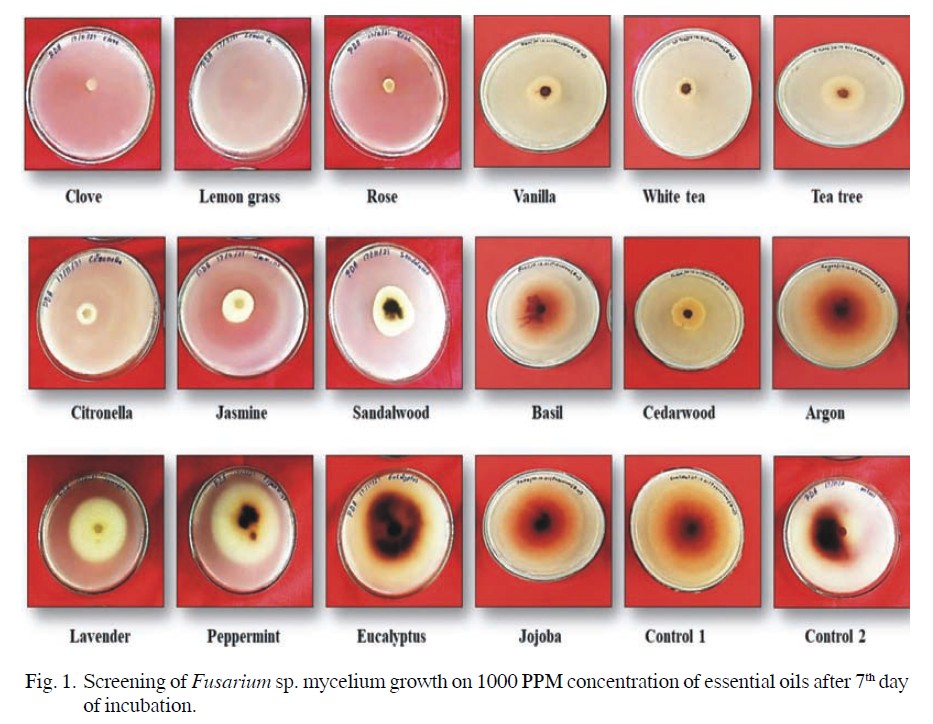Screening of Essential Oils against the Banana Wilt Pathogen Fusarium sp. from Arunachal Pradesh, a State of India
Main Article Content
Abstract
Fusarium wilt disease affects numerous commercially significant crops and is controlled by synthetic fungicides. The utilization of natural compounds derived from plant sources has been prioritized in the search for substitutes for fungicides. They are safer for the environment and less harmful. Therefore, in this present study inhibitory effect of sixteen essential oils, namely Lemon grass, clove, Lavender, Jasmine, peppermint, Citronella, Sandalwood, Cedarwood, Argan, Jojoba, White tea, Basil, Vanilla, Tea tree, rose and Eucalyptus essential oils were screened. The influence of four concentrations (1000, 1500, 2000, and 2500 ppm) of each essential oil was tested against the fusarium wilt of banana. The radial mycelium growth and mycelial growth inhibition percentages were calculated. Based on radial mycelium growth and growth inhibition After 7th day of proper incubation in controlled conditions, it was observed that clove, lemon grass, rose, vanilla, white tea, citronella, and jasmine were the most effective essential oils against the pathogenic fungus. There was 100% inhibition in the growth of phytopathogenic fungi at 1500 ppm concentration by clove essential oil. The essential oils of lemon grass rose, and citronella have been proven to limit the colony growth of Fusarium oxysporum, and 100% inhibition was observed at concentrations of 2000 and 2500 ppm after the 7th day of the incubation period.
Article Details

This work is licensed under a Creative Commons Attribution-NonCommercial-ShareAlike 4.0 International License.
References
Bakkali, F., Averbeck, S., Averbeck, D., & Idaomar, M. (2008). Biological effects of essential oils – a review. Food and Chemical Toxicology, 46(2), 446-475.
Beckman, C. H. (1987). The nature of wilt diseases of plants. American Phytopathological Society.
Burt, S. (2004). Essential oils: Their antibacterial properties and potential applications in foods—a review. International Journal of Food Microbiology, 94(3), 223-253.
de Groot, A. C., & Schmidt, E. (2016). Essential oils, part III: Chemical composition. Dermatitis, 27(4), 161-169.
Hennessy, C., Walduck, G., Daly, A., & Padovan, A. (2005). Weed hosts of Fusarium oxysporum f. sp. cubense tropical race 4 in northern Australia. Australasian Plant Pathology, 34(1), 115-117.
Johnson, L. F., & Curl, E. A. (1972). Methods for research on the ecology of soil-borne plant pathogens. Burgess Publishing Company.
Lambert, R. J., Skandamis, P. N., Coote, P. J., & Nychas, G. J. (2001). A study of the minimum inhibitory concentration and mode of action of oregano essential oil, thymol, and carvacrol. Journal of Applied Microbiology, 91, 453-462.
Lucas, G. C., Alves, E., Pereira, R. B., Perina, F. J., & Souza, R. M. D. (2012). Antibacterial activity of essential oils on Xanthomonas vesicatoria and control of bacterial spot in tomato. Pesquisa Agropecuária Brasileira, 47, 351-359.
Rana, I. S., Rana, A. S., & Rajak, R. C. (2011). Evaluation of antifungal activity in essential oil of Syzygium aromaticum (L.) by extraction, purification, and analysis of its main component eugenol. Brazilian Journal of Microbiology, 42(4), 1269-1277.
Pegg, K. G., Coates, L. M., O’Neill, W. T., & Turner, D. W. (2019). The epidemiology of Fusarium wilt of banana. Frontiers in Plant Science, 10, 1395.
Pittaway, P. A., Nasir, N., & Pegg, K. G. (1999). Soil receptivity and host-pathogen dynamics in soils naturally infested with Fusarium oxysporum f. sp. cubense, the cause of Panama disease in bananas. Australian Journal of Agricultural Research, 50(4), 623-628.
Ploetz, R. C. (2015). Fusarium wilt of banana. Phytopathology, 105(12), 1512-1521.
Rodriguez-Galvez, E., & Mendgen, K. (1995). The infection process of Fusarium oxysporum in cotton root tips. Protoplasma, 189(1-2), 61-72.
Sukatta, U., Haruthaithanasan, V., Chantarapanont, W., Dilokkunanant, U., & Suppakul, P. (2008). Antifungal activity of clove and cinnamon oil and their synergy against postharvest decay fungi of grape in vitro. Agriculture and Natural Resources, 42(5), 169-174.
Ultee, A., Slump, R. A., Steging, G., & Smid, E. J. (2000). Antimicrobial activity of carvacrol towards Bacillus cereus on rice. Journal of Food Protection, 63, 620-624.
Nelson, P. E., Toussoun, T. A., & Marasas, W. F. O. (1983). Fusarium species: An illustrated manual for identification. University Park, PA: Pennsylvania State University Press.
Hassan, B., Zouheir, C., Redouane, B., Mohammed, C., Mustapha, E. M., & Elbachir, H. (2022). Antifungal activity of the essential oils of Rosmarinus officinalis, Salvia officinalis, Lavandula dentata, and Cymbopogon citratus against the mycelial growth of Fusarium oxysporum f. sp. Albedinis. Arabian Journal of Medicinal and Aromatic Plants, 8(1), 108-133.
Sharma, A., Rajendran, S., Srivastava, A., Sharma, S., & Kundu, B. (2017). Antifungal activities of selected essential oils against Fusarium oxysporum f. sp. lycopersici 1322, with emphasis on Syzygium aromaticum essential oil. Journal of Bioscience and Bioengineering, 123(3), 308-313.
Grover, R. K., & Moore, J. D. (1962). Toximetric studies of fungicides against the brown rot organisms, Sclerotinia fructicola and S. laxa. Phytopathology, 52, 876-879.
